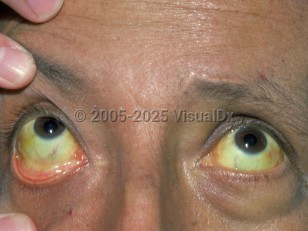Drug-induced jaundice
Alerts and Notices
Important News & Links
Synopsis

Some drugs may induce hemolysis, leading to increased circulating bilirubin. Other drugs can cause hepatotoxicity, leading to hepatocellular damage and subsequent decreased bilirubin conjugation by the liver. Finally, drugs may induce cholestasis or bile duct injury, decreasing excretion of bilirubin. Many prescription medications, illicit drugs, and over-the-counter supplements, either at typical doses or overdoses, have been associated with jaundice from a variety of mechanisms of liver injury.
The hallmark symptom of drug-induced jaundice will be yellowing of the skin. This can occur in the setting of an otherwise asymptomatic patient, or in a patient with sequelae of hepatitis and even liver failure, marked by altered mental status, coagulopathy, and fatigue. Some patients with hyperbilirubinemia will report pruritus.
Codes
R17 – Unspecified jaundice
T50.995A – Adverse effect of other drugs, medicaments and biological substances, initial encounter
SNOMEDCT:
1179217006 – Cholestatic jaundice caused by drug
18165001 – Jaundice
278993004 – Drug-induced
Look For
Subscription Required
Diagnostic Pearls
Subscription Required
Differential Diagnosis & Pitfalls

Subscription Required
Best Tests
Subscription Required
Management Pearls
Subscription Required
Therapy
Subscription Required
Drug Reaction Data
Subscription Required
References
Subscription Required
Last Updated:07/18/2019

